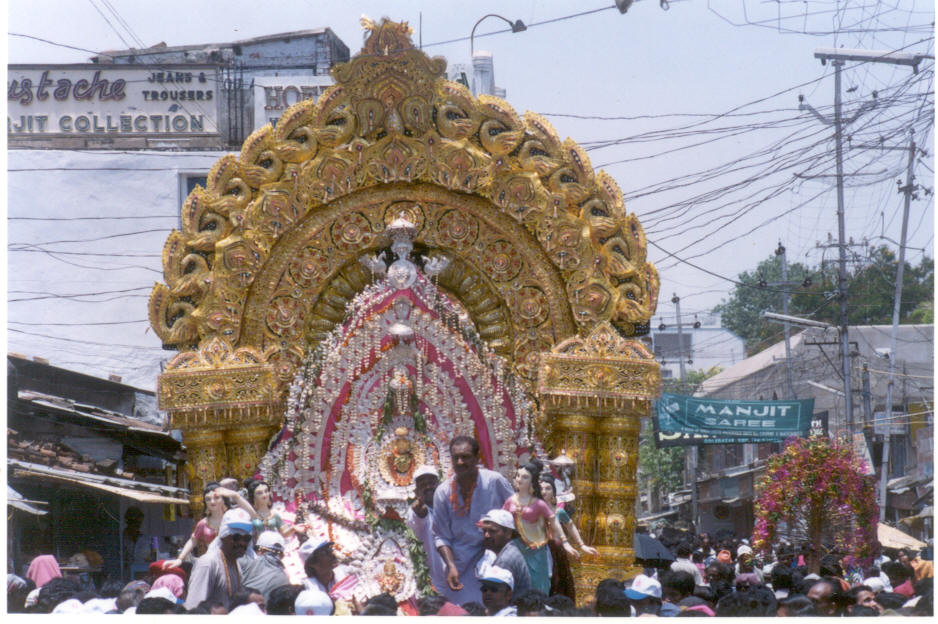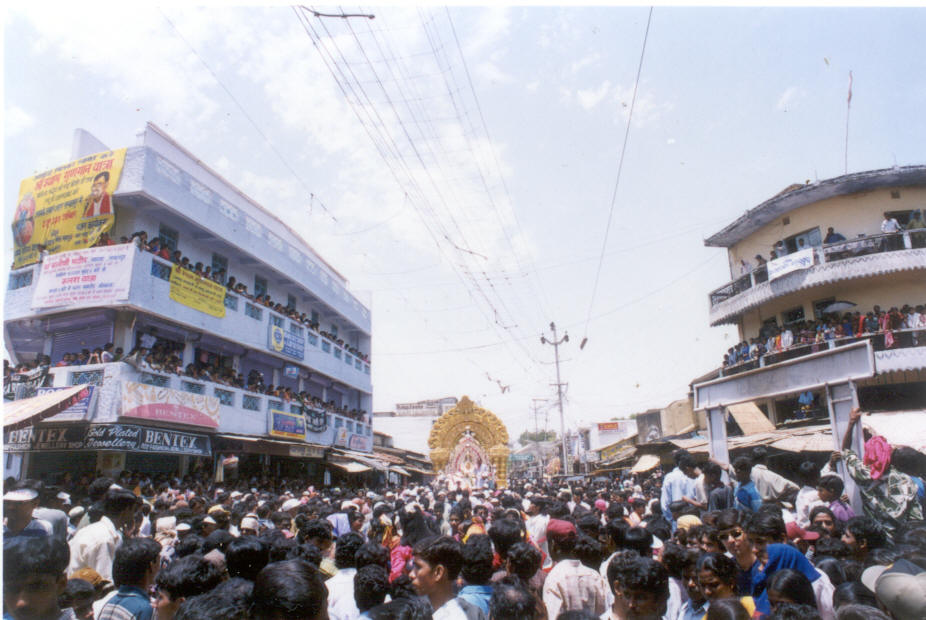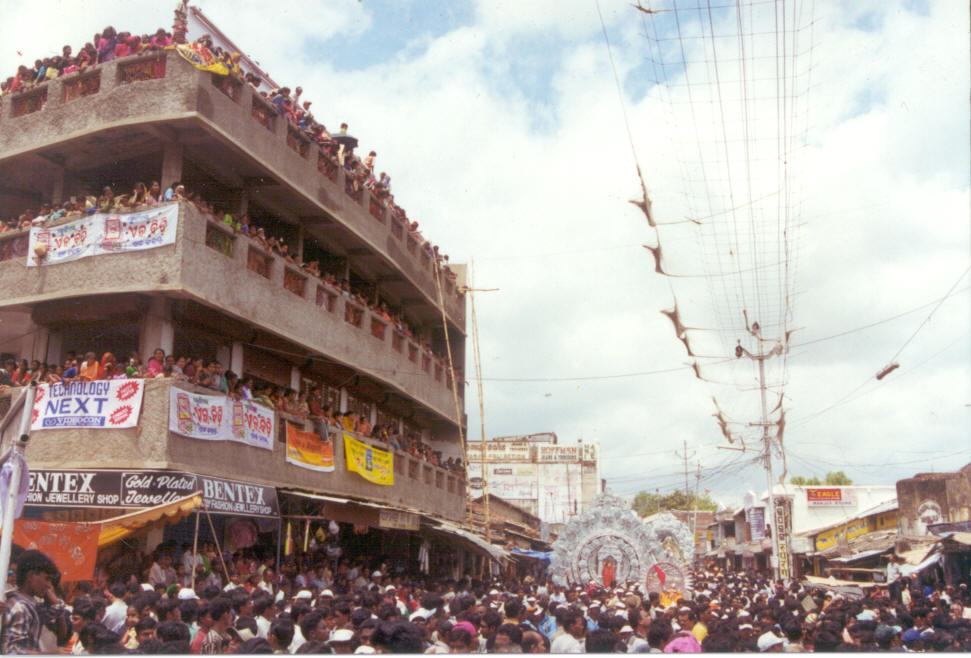 Sambalpur
and the entire Western Part of Orissa has earned a special place in the cultural
history of Orissa for its glorious past and ancient tradition, art and
architecture. It was a major centre of Tantric tradition in the ancient time.
Several temples denoted to Devi Pithas in the area points at that. The western
part of Orissa is a storehouse of several deities. Sameleswari of Sambalpur,
Patneswari of Patnagadh, Sureswari of Suvernapura, Nrusingadeva of Nursinghnath,
Siba Temple of Chardar, Papakhyaghat of Sonpur, Vedabyas of Roulkela, Maheswara
of Koiligugar, Budharaja Temple of Budharaja hills of Sambalpur, the Rameswara
of Sambalpur, Satidraha Siba temple of Padampur are only a few to mentioned.
Sambalpur
and the entire Western Part of Orissa has earned a special place in the cultural
history of Orissa for its glorious past and ancient tradition, art and
architecture. It was a major centre of Tantric tradition in the ancient time.
Several temples denoted to Devi Pithas in the area points at that. The western
part of Orissa is a storehouse of several deities. Sameleswari of Sambalpur,
Patneswari of Patnagadh, Sureswari of Suvernapura, Nrusingadeva of Nursinghnath,
Siba Temple of Chardar, Papakhyaghat of Sonpur, Vedabyas of Roulkela, Maheswara
of Koiligugar, Budharaja Temple of Budharaja hills of Sambalpur, the Rameswara
of Sambalpur, Satidraha Siba temple of Padampur are only a few to mentioned.
Sitalsasthi - is observed on the basis of the marriage of Gouri and Shankar
- as depicted in the Siba Puran. When Narakasura the king of Narakapura was
causing terror and devastation all over (Swarga, Martiya and Patala) all the
Devatas approached Vishnu to find out a solution. Vishnu was undone; as Bramha
gave Narakasura in boon that only the son of Siba can kill him. Narakasura knows
fully well that Siba was a Bramachari and he will never have a son, and further
Siba was in deep meditation. As suggested by Vishnu all the Devatas
approached Ma Mahasakti to take berth as Parvati. Ma Mahasakti born as
Parvati the daughter of Himalaya. Narada persuaded Parvati to seek Siaba in
marriage. Parvati set in meditation, even after ages passed Siba’s dhyna could
not be broken. Then again all the Devatas approached Vishun to solve the
problem. Suggested by Vishnu Kamadeva took his bow and threw kamabana at Siba.
Siba wakes up – open his third eye – and burnt Kama as a punishment since then
Kama took the shape of Ananga. What ever it is Parvati’s meditation was
fulfilled.
Before the marriage Siba wanted to test Parvati, to know how deeply she wants
him. He incarnate him self as a batu bramana and told Parvati that, Oh! Parvati,
you are young and beautifl, why do you chooses to marry a old fellow who lives
in swasana, wears tree bark - snakes as ornaments.
I know that Maheswara you want to marry, a half naked fellow, looks ugly
no one for sure knows his kula-gotra, how could you ever be happy
with such a nomad. Listing to the suggestion of the Batu- Brahman she got angry,
and told Oh! Brahman, ever after reading so much shastras you are still ignorant
about Siba, how foolish you are. I am not bothered whether he is old or young,
ugly or handsome I am not marring him of his handsomeness, I am attracted
towards him for his knowledge. I will not accept any one else other then him in
marriage.
Satisfied with all his test, Siba appeared in his divine self. On the Jesta
Suklapakhya Sathi they got married. Kartilaya was born and later he killed
Narakasura, and all the being lived happily ever after.
Sambalpur has earned the name as the Saiba tirtha and Sakti Pitha from the
ancient time. The marriage of Siba and Parvati is celebrated as Sitalsathi for
several years from now. It represents the union of Siba and Mahasakti. No one
for sure knows when actually it started. However, from the records it is know
that for the last 300 years it is been observed.
Historical Evidence: King Ajit Singh son of Chatra Sai of the Chowhan dynasty
(1695-1766) ruled Sambalpur for 72 years, in a very peaceful manner.
It was possible only for his strong religiously faith. As he was a
Vaisnava in his religions faith and believe he used to spend much time at Puri.
He wanted to establish Sambalpur as a religions place.
In the ancient time Brahmins were not there in this past. King Ajit Singh
requested some Brahmin family form Puri to settle at Ajitpur Sasan (present day
Sasan). This created displeasure amongst the tribal and other caste of people
residing in the area. To create harmony amongst the tribal and other caste he
establish several other temples in the area. Ajit Sing knew that Sambalpur was
famous as a Saktipitha in the ancient time, and the union of Siba and Sakti were
worshipped. Dewan Daxina Ray suggests the king to establish and contribute
generously to the temples of the Astha Sambhu in the area. King Baliar Singn has
erected the temple at Huma the abode of
Vimaleswar the chief of the deities between the 'Asta Sambhu'. Ajit Sing
builds seven other temples for the Sambhus. (Kedarnath of Ambabhona,
Biswanatha of Deogaon, Balunkeswar of Gaisama, Maneswar of Maneswar, Swapneswar
of Sorna, Bisweswara of Soranda and Nilakanteswar of Nilji).

Keeping in vies the famous Ratha Jatra of
Puri, he started the Sitalasasthi Jatra the marriage of Hara and Parvati at
Sambalpur on the Jesta Suklapakhya Sasthi. The God and Goddess are treated and
married like human being. Patarpandi (Nirbandha) Guagunda (Invitation) are
observed religiously. As during the
Ratha Jatra – Jagannath is treated as Ganadevata, like wise manner Siba and
Parvati are also treated as Ganadevata. A family act as the father and mother of
Parvati, and offer hand of Parvati in marriage with Siba. Since Siba is ‘Sayam
Bu’ no one act as his father and mother. He starts his marriage procession along
with other Gods and Goddesses from his temple. Hanuman takes charge and leads
the procession to the bride’s residence. The family of the Goddesses welcome the
barat procession (as we do in our marriages). The idols are kept in a
beautifully decorated palanquin, the father and mother and other relatives of
Parvati perform the Kanyadana and the marriage is completed. The next day
the procession returns back to the Temple with Parvati, folkdance, folk music,
different forms of other dances and music different medhas are the main
attraction of this procession. People from all over in lack rush to Sambalpur
form nearby places to see the procession. For two days Sambalpur turns into
swarga, a devastali.
Kings are gone, kingdom vanishes still
Sitalasasthi Jatra is celebrated till date with all its glory. Earlier
Jhaurapada and Nandapada were celebrating Sitalasasthi, since 1972 Mudipada has
also joined the festival. Different committees are formed; the administration,
police and other department were also involved to see that the festival is
observed in a peaceful manner.

 Sambalpur
and the entire Western Part of Orissa has earned a special place in the cultural
history of Orissa for its glorious past and ancient tradition, art and
architecture. It was a major centre of Tantric tradition in the ancient time.
Several temples denoted to Devi Pithas in the area points at that. The western
part of Orissa is a storehouse of several deities. Sameleswari of Sambalpur,
Patneswari of Patnagadh, Sureswari of Suvernapura, Nrusingadeva of Nursinghnath,
Siba Temple of Chardar, Papakhyaghat of Sonpur, Vedabyas of Roulkela, Maheswara
of Koiligugar, Budharaja Temple of Budharaja hills of Sambalpur, the Rameswara
of Sambalpur, Satidraha Siba temple of Padampur are only a few to mentioned.
Sambalpur
and the entire Western Part of Orissa has earned a special place in the cultural
history of Orissa for its glorious past and ancient tradition, art and
architecture. It was a major centre of Tantric tradition in the ancient time.
Several temples denoted to Devi Pithas in the area points at that. The western
part of Orissa is a storehouse of several deities. Sameleswari of Sambalpur,
Patneswari of Patnagadh, Sureswari of Suvernapura, Nrusingadeva of Nursinghnath,
Siba Temple of Chardar, Papakhyaghat of Sonpur, Vedabyas of Roulkela, Maheswara
of Koiligugar, Budharaja Temple of Budharaja hills of Sambalpur, the Rameswara
of Sambalpur, Satidraha Siba temple of Padampur are only a few to mentioned.
